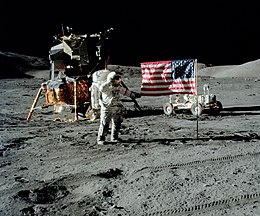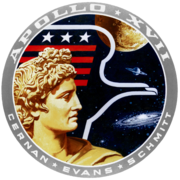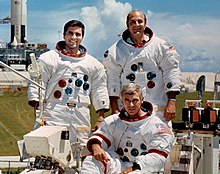 Gene Cernan salutes the U.S. flag, with the Apollo Lunar Module Challenger and Lunar Roving Vehicle in the background | |
| Mission type | Crewed lunar landing (J) |
|---|---|
| Operator | NASA |
| COSPAR ID | |
| SATCAT no. |
|
| Mission duration | 12 days, 13 hours, 51 minutes, 59 seconds |
| Spacecraft properties | |
| Spacecraft |
|
| Manufacturer |
|
| Launch mass | 48,609 kg (107,165 lb)[2] |
| Landing mass | 5,500 kg (12,120 lb)[3] |
| Crew | |
| Crew size | 3 |
| Members | |
| Callsign |
|
| EVAs | 1 in cislunar space |
| EVA duration | 1 hour, 5 minutes, 44 seconds (spacewalk to retrieve film cassettes) |
| Start of mission | |
| Launch date | December 7, 1972, 05:33:00 UTC (12:33 am EST)[4] |
| Rocket | Saturn V SA-512 |
| Launch site | Kennedy, LC-39A |
| End of mission | |
| Recovered by | USS Ticonderoga |
| Landing date | December 19, 1972, 19:54:58 UTC[5] |
| Landing site | South Pacific Ocean (17°53′S 166°07′W / 17.88°S 166.11°W) |
| Lunar orbiter | |
| Spacecraft component | Command and service module |
| Orbital insertion | December 10, 1972, 19:53:55 UTC[5] |
| Orbital departure | December 16, 1972, 23:35:09 UTC[5] |
| Orbits | 75 |
| Lunar lander | |
| Spacecraft component | Lunar Module |
| Landing date | December 11, 1972, 19:54:58 UTC[5] |
| Return launch | December 14, 1972, 22:54:37 UTC[5] |
| Landing site | Taurus–Littrow 20°11′27″N 30°46′18″E / 20.1908°N 30.7717°E[6] |
| Sample mass | 115 kg (254 lb) |
| Surface EVAs | 3 |
| EVA duration |
|
| Lunar rover | |
| Distance driven | 35.7 km (22.2 mi) |

 Left to right: Schmitt, Cernan (seated), Evans | |
Apollo 17 (December 7–19, 1972) was the eleventh and final mission of NASA's Apollo program, the sixth and most recent time humans have set foot on the Moon or traveled beyond low Earth orbit. Commander Gene Cernan and Lunar Module Pilot Harrison Schmitt walked on the Moon, while Command Module Pilot Ronald Evans orbited above. Schmitt was the only professional geologist to land on the Moon; he was selected in place of Joe Engle, as NASA had been under pressure to send a scientist to the Moon. The mission's heavy emphasis on science meant the inclusion of a number of new experiments, including a biological experiment containing five mice that was carried in the command module.
Mission planners had two primary goals in deciding on the landing site: to sample lunar highland material older than that at Mare Imbrium and to investigate the possibility of relatively recent volcanic activity. They therefore selected Taurus–Littrow, where formations that had been viewed and pictured from orbit were thought to be volcanic in nature. Since all three crew members had backed up previous Apollo lunar missions, they were familiar with the Apollo spacecraft and had more time for geology training.
Launched at 12:33 a.m. Eastern Standard Time (EST) on December 7, 1972, following the only launch-pad delay in the course of the whole Apollo program that was caused by a hardware problem, Apollo 17 was a "J-type" mission that included three days on the lunar surface, expanded scientific capability, and the use of the third Lunar Roving Vehicle (LRV). Cernan and Schmitt landed in the Taurus–Littrow valley, completed three moonwalks, took lunar samples and deployed scientific instruments. Orange soil was discovered at Shorty crater; it proved to be volcanic in origin, although from early in the Moon's history. Evans remained in lunar orbit in the command and service module (CSM), taking scientific measurements and photographs. The spacecraft returned to Earth on December 19.
The mission broke several records for crewed spaceflight, including the longest crewed lunar landing mission (12 days, 14 hours),[7] greatest distance from a spacecraft during an extravehicular activity of any type (7.6 kilometers or 4.7 miles), longest time on the lunar surface (75 hours), longest total duration of lunar-surface extravehicular activities (22 hours, 4 minutes),[8] largest lunar-sample return (approximately 115 kg or 254 lb), longest time in lunar orbit (6 days, 4 hours),[7] and greatest number of lunar orbits (75).[9]
- ^ Orloff 2004, Statistical Tables: Launch Vehicle/Spacecraft Key Facts.
- ^ Orloff & Harland 2006, p. 585.
- ^ Orloff & Harland 2006, p. 581.
- ^ Cite error: The named reference
astronautixwas invoked but never defined (see the help page). - ^ a b c d e Orloff, Richard W. (2000). "Apollo 17, pp243". Apollo by the Numbers (PDF). NASA. NASA SP-2000-4029. Archived (PDF) from the original on October 9, 2022. Retrieved December 12, 2022.
- ^ "NASA NSSDC Master Catalog – Apollo 17 descent stage". NASA. Archived from the original on April 17, 2019. Retrieved January 1, 2011.
- ^ a b "Astronaut Friday: Ronald Evans". Space Center Houston. December 28, 2018. Archived from the original on February 8, 2022. Retrieved February 7, 2022.
- ^ Cite error: The named reference
eva tablewas invoked but never defined (see the help page). - ^ Orloff 2004, Apollo 17: The Eleventh Mission.